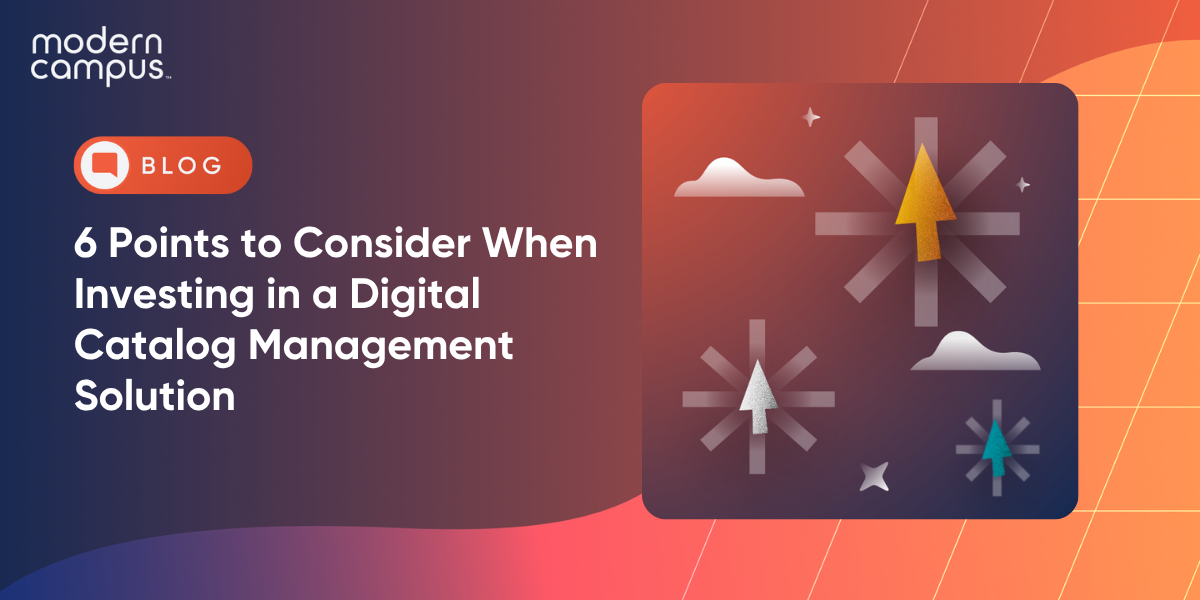6 Points to Consider When Investing in a Digital Catalog Management Solution
If you’ve already moved past the old paper course catalog or even upgraded to a basic digital option, great move. But now comes the hard part: finding a higher ed digital catalog management solution that actually makes life easier for your staff, improves the student experience and supports your institution’s long-term goals. With so many vendors flooding the market, it’s not easy to cut through the noise and find the right fit.
The urgency is underscored by EDUCAUSE's 2025 Top 10 IT Issues, which highlight the need to update and unify digital infrastructure to enhance institutional efficiency and effectiveness.
We’ll walk through key factors to evaluate when selecting a digital catalog management system. From integration with your Student Information System to how well it supports catalog creation, continuing education and long-term scalability, these insights will help you confidently choose a solution built for today’s learners—and tomorrow’s.
What to Look for in a Higher Ed Digital Catalog Management Solution
When choosing a digital catalog tool, prioritize a system that enhances efficiency, ensures compliance and delivers a modern student experience. To support your institution’s long-term goals, here are some advanced features and capabilities to keep an eye out for when evaluating a higher ed digital catalog management system:
Future-Ready Architecture and Regular Updates
Your solution should evolve as your institution does. Look for platforms built with scalability in mind and a clear roadmap for regular updates. A stagnant system could lock you into outdated processes or force costly overhauls later.

Compliance and Accessibility Standards
Ensure the platform meets WCAG accessibility standards and provides tools to help keep your course catalog compliant with accreditation requirements. This is especially important as regulatory guidelines continue to evolve across higher education.
Role-Based Permissions and Workflow Automation
A robust catalog management system should allow you to assign roles and automate approvals, empowering faculty, curriculum committees and administrators to collaborate without bottlenecks. You can speed up catalog creation while ensuring version control and accuracy.
Audit Trails and Version History
Institutions need to track who made changes and when, especially for accreditation reviews or internal reporting. Version histories and detailed audit trails offer transparency and accountability without needing to manage everything manually.
Personalized Catalog Experiences for Prospective Students
The course catalog is often one of the first touchpoints for prospective students. A top-tier system will offer dynamic search, filters by interest area or career outcomes and personalized pathways that support continuing education and non-traditional learners.
Integrated Analytics and Reporting
A modern platform should offer actionable insights into how students are engaging with the catalog. Which programs are being viewed most? Where are users dropping off? Analytics can help drive content updates and inform marketing or curriculum decisions based on up-to-date information.
Now that you know what a strong higher ed digital catalog management system should offer, let’s explore six strategic factors that will help you evaluate potential partners and find the right fit for your institution.
1. Trust Comes with Time: Choose a Proven Catalog Partner in Higher Education
In the crowded world of higher education technology, every vendor claims to be the top choice. But when you’re investing in a digital catalog management solution, flashy promises don’t cut it. Real results and reputation do.
One of the best ways to assess a vendor’s credibility is by digging into their track record with other colleges and universities. A seasoned partner brings insights, best practices and proven processes that can help you hit the ground running.
Here are a few key questions to ask as you evaluate their experience:
- How long have they been working in the higher education space?
- How many colleges and universities currently use their catalog management system?
- How many full catalog implementations have they successfully delivered?
Vendors with deep experience understand the technical side of catalog creation as well as the operational and institutional challenges behind it. The more you can learn about their customer base and success stories, the more confidently you can move forward.
2. Ensure Seamless Integration with Your Student Information System
Most vendors will confidently say their solution integrates with your Student Information System (SIS), but how they implement matters. When you're managing critical academic data and workflows, surface-level compatibility won’t cut it. You need a catalog management system that offers deep, reliable and scalable connections to your existing tech stack.
Smooth SIS integration is the backbone of efficient curriculum management and accurate catalog creation. Without it, your team could face data silos, manual workarounds and unexpected costs.

Ask these questions to dig beneath the surface:
- Does their solution provide a true out-of-the-box connector, or will you need a third-party tool to make it work?
- Is there an additional cost for integration or ongoing support?
- How often is the connector updated to match changes in SIS platforms?
- Are there limits to the types of data that can be mapped or synced between systems?
Getting clear answers upfront will help you avoid budget surprises and ensure your chosen management software supports both current and future institutional needs.
3. Learn from Peer Institutions: What Other Colleges and Universities Are Choosing
There are nearly 6,000 colleges and universities in the U.S., and no two are exactly alike. Your institution’s needs for curriculum management and student communication will vary depending on size, demographics, region and mission.
That’s why it’s smart to look at what similar institutions are doing with their digital catalog management systems. Whether it’s a community college expanding continuing education offerings or a large university streamlining course catalog updates across departments, there’s value in studying what’s working and what’s not.
Peer insights can help you narrow your options, avoid common pitfalls and find a solution that aligns with your institution’s specific needs and long-term goals.
4. Speed Matters: Streamline Catalog Creation and Updates
Higher education institutions must quickly adapt to the ever-changing landscape of course offerings. The point of moving to a digital solution is to be agile in responding to students' changing expectations. Being slow in adopting the solution defeats the purpose.
When considering a catalog solution, look at the support that your partner offers. Make sure they do the heavy lifting for you. Some important questions that you want to ask are:
- How long does it take to go live with the solution?
- What is the extent of support offered with the implementation and maintenance of the solution? (Hint: read the service SLAs)
- What technical expertise does the solution require to manage?
- Does the vendor train your staff on using the solution? If yes, how much does it cost?
5. Turn Your Course Catalog into a Strategic Marketing Tool
Today’s prospective students are doing their research, and they expect instant access to clear, relevant information. One of the most powerful ways to showcase the value of your programs is through a dynamic, easy-to-navigate course catalog that lives right on your website.
A modern catalog management system becomes a key part of your digital marketing strategy. By highlighting program outcomes, career pathways, faculty expertise and flexible learning options, your catalog can speak directly to what students care about: ROI, employability and how a degree aligns with their goals.

Instead of treating your catalog like a static reference tool, think of it as an always-on, SEO-friendly marketing tool that helps students understand your value and drives them to apply.
6. Look for Management Software That Supports Curriculum Growth and Continuing Education
Your institution’s needs today won’t be the same five years from now. Invest in management software that not only solves your current challenges but also supports your future growth, whether that’s scaling curriculum development, launching new programs or expanding into continuing education.
The right solution won’t force you to rip and replace systems down the road. Instead, it should integrate seamlessly with your existing technology stack and offer a broader ecosystem of tools designed specifically for higher education.
Ask yourself: Can this platform evolve with us? Does the vendor offer connected tools for scheduling, engagement or non-traditional learners? A partner with a comprehensive, forward-looking approach can help you streamline operations now and accelerate innovation in the years to come.
Invest in a Scalable Curriculum Management Solution
Choosing the right higher ed digital catalog management solution is about finding a platform that simplifies operations, supports curriculum management, integrates cleanly with your Student Information System and helps your institution stand out to prospective students. Whether you’re focused on improving the student experience, expanding continuing education offerings or building a more agile tech ecosystem, your catalog system plays a bigger role than you might think.
That’s why we’ve built our solutions with the future of higher education in mind. At Modern Campus, we’ve helped more than 800 institutions publish nearly 9,000 course catalogs, each one designed to engage students, reduce staff time and serve as a powerful marketing tool that drives enrollment. With deep experience in the space and a scalable platform you can grow with, we’re ready to help your institution manage change and stay ahead. Request a demo and see how Modern Campus can help.
Last updated: June 10, 2025



